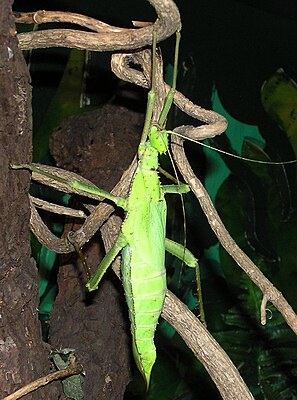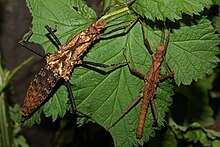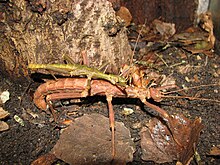Heteropterygidae
| Heteropterygidae | ||||||||||||
|---|---|---|---|---|---|---|---|---|---|---|---|---|

Malay giant ghost insect ( Heteropteryx dilatata ), ♀ |
||||||||||||
| Systematics | ||||||||||||
|
||||||||||||
| Scientific name | ||||||||||||
| Heteropterygidae | ||||||||||||
| Kirby , 1896 |





The Heteropterygidae are in Southeast Asia -based family of the order of Gespenstschrecken , to which are counted more than 120 kinds described (beginning of 2018). The name giant ghosts sometimes used for the Heteropterygidae is misleading, as it is also used for other species that do not belong to this family. In addition, only the representatives of the subfamily Heteropteryginae reach a size that would justify this name.
morphology
The representatives of this family include both very small species, such as the Planispectrum species, which are only 19 to 35 millimeters long , as well as very large and bulky species, such as the Malay giant ghost insect ( Heteropteryx dilatata ) up to 17 centimeters long . They have certain morphological characteristics in common: One of the most striking is the females' abdomen, which is wider towards the middle . In adult females, this area is not only very wide, but also significantly increased due to the eggs that are permanently and often produced in large numbers. In the females of the subfamilies Heteropteryginae and Obriminae , the abdomen ends in a pointed spine that surrounds the actual ovipositor . This is formed ventrally from the eighth sternite , which is referred to here as the subgenital plate or operculum. Dorsally, the laying spine consists of the eleventh tergum, known as the supraanal plate or epiproct . The smaller males have a central abdomen with a rounded cross section, which, in contrast to the females, is thinnest here. The thickened end of the abdomen is formed ventrally by the subgenital plate and dorsally by the eighth, ninth and the tenth tergum, known as the anal segment. Except for Miroceramia westwoodii , the representatives of the Obriminae and Dataminae have no wings, while the Heteropteryginae have wings. With them, the front wings ( Tegmina ) and mostly also the hind wings are shortened, as in the Haaniella species. In the males of the Malay giant ghost insect ( Heteropteryx dilatata ), the tegmina cover almost the entire abdomen. However, the fully developed hind wings below enable the animals only to fly very briefly. The body can be covered with numerous pointed spines. There are also species with few, more or less pointed thorns or tubercles , which can be found mainly on the upper side of the thorax . The head, which is directed diagonally downwards, often has species-specific structures on the mostly conical apex. These can be thorns, for example, which act like a crown in many species.
Reproduction and Life Expectancy
The adult females lay their relatively large eggs several centimeters deep in the ground using the laying stinger, if available, almost always individually. The species without the spiky laying apparatus also lay their eggs on or in the ground. The nymphs hatch from them after two to twelve months , which are quite large even in smaller species with a length of at least ten millimeters. In turn, it often takes up to a year for them to grow into an imago . Besides species with an average life expectancy, there are many species that reach an amazing age. So could Oskar V. Conle at a tomboy female of Haaniella scabra an age of more than five years to prove.
Defense behavior
Typical of the winged representatives, i.e. those of the subfamily of the Heteropteryginae , is a pronounced defensive behavior, in which the opponent is initially threatened by a defensive stridulation generated with the wings . Finally, the abdomen and the thorny hind legs are raised, the rails of which are knocked against the thighs like a jackknife when tactile stimuli , the aim of which is to pinch the opponent. In contrast, the less armed species are clearly better camouflaged. In particular, the representatives of the Dataminae have almost perfected the mimesis of bark and short branches.
Systematics
In 1896, William Forsell Kirby summarized various species belonging to the Bacillidae family in the subfamily Heteropteryginae. Exactly 100 years later, Oliver Zompro raised the subfamily to the rank of family and thus the three tribes contained therein also became subfamilies. Kirby 1896 is to be prioritized as first author, although Zompro 1996 is occasionally mentioned. Another place where Rehn is incorrectly mentioned, 1904. Probably James Abram Garfield Rehn is meant here. In 2016, among other things, the tribes within the Obriminae were reworked in an extensive work .
The three subfamilies and their further subdivision are shown here down to the genus level:
-
Dataminae
Rehn, JAG & Rehn, JWH , 1939
- Datamini Rehn, JAG & Rehn, JWH , 1939
- Dares Stål , 1875
- Epidares Redtenbacher , 1906
- Hainanphasma Ho , 2013
- Orestes Redtenbacher , 1906
- Planispectrum Rehn, JAG & Rehn, JWH , 1939
- Pylaemenes Stål , 1875
- Spinodares Bragg , 1998
- Datamini Rehn, JAG & Rehn, JWH , 1939
-
Heteropteryginae Kirby , 1896
- Heteropterygini Kirby , 1904
- Haaniella Kirby , 1904
- Heteropteryx Gray, GR , 1835
- Heteropterygini Kirby , 1904
-
Obriminae Brunner von Wattenwyl , 1893
( Syn. = Therameninae Karny , 1923)-
Obrimini Brunner von Wattenwyl , 1893
- Obrimus group
-
Stenobrimus group
- Stenobrimus Redtenbacher , 1906
-
Theramenes group
- Eubulides Stål , 1877
- Heterocopus Redtenbacher , 1906
- Theramenes Stål , 1875
- Mearnsiana Rehn, JAG & Rehn, JWH , 1939
-
Tisamenini Hennemann , Conle , Brock & Seow-Choen , 2016
- Hoploclonia Stål , 1875
- Ilocano Rehn, JAG & Rehn, JWH , 1939
- Pterobrimus Redtenbacher , 1906
- Tisamenus Stål , 1875
-
Miroceramiini Zompro , 2004
- Miroceramia Günther , 1934
-
Obrimini Brunner von Wattenwyl , 1893
swell
- ^ A b c Frank H. Hennemann , Oskar V. Conle , Paul D. Brock & Francis Seow-Choen : Zootaxa 4159 (1): Revision of the Oriental subfamiliy Heteropteryginae Kirby, 1896, with a re-arrangement of the family Heteropterygidae and the descriptions of five new species of Haaniella Kirby, 1904. (Phasmatodea: Areolatae: Heteropterygidae) , Magnolia Press, Auckland, New Zealand 2016, ISSN 1175-5326
- ↑ Oliver Zompro : Dwarf forms of Phasmatodea - the smallest among the giants , Arthropoda 16 (3) November 2008, Sungaya-Verlag Kiel. ISSN 0943-7274
- ↑ Ingo Fritzsche : Poles - Carausius, Sipyloidea & Co. , Natur und Tier Verlag, Münster 2007, ISBN 978-3-937285-84-9
- ↑ Christoph Seiler, Sven Bradler , Rainer Koch: Phasmids - care and breeding of ghost horrors, stick insects and walking leaves in the terrarium . bede, Ruhmannsfelden 2000, ISBN 3-933646-89-8
- ↑ Oliver Zompro: Poles, ghosts, walking leaves - phasmid systematics at a glance I. , Arthropoda 17 (1) April 2009, Sungaya-Verlag Kiel. ISSN 0943-7274
- ^ Phasmatodea page by Oskar V. Conle and Frank H. Hennemann
- ↑ Oliver Zompro: contributions to the knowledge of Philippine Phasmiden I . Entomologische Zeitschrift (1996) 106 (4), pp. 160-164.
- ↑ Oliver Zompro: Revision of the genera of the Areolatae, including the status of Timema and Agathemera (Insecta, Phasmatodea) , Goecke & Evers, Keltern-Weiler 2004, pp. 191-240, ISBN 978-3931374396
- ↑ DahmsTierleben
- ^ Paul D. Brock, Thies H. Buescher & Edward W. Baker: Phasmida Species File Online . Version 5.0. (accessed on December 29, 2018)